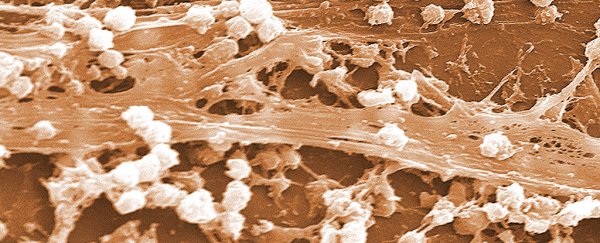We already have a lot to worry about when it comes to bacteria, as more and more strains becoming resistant to our dwindling arsenal of antibiotics. Last year, a woman in the US was killed by a superbug resistant to every antibiotic available.
But scientists continue to discover more worrying facts about the apparently simple, single-cell organisms we call bacteria: such as the way they beam out electrical signals to recruit other species to join their communities.
That's the conclusion of new research studying biofilms, the thin layer of cells and slime formed whenever bacteria glue themselves to a surface, and it can teach us more about how these microscopic communities live.
Biofilms are found in all kinds of places, from the plaque on your teeth to the underside of rocks, and they're a particular concern for researchers, because instead of just one strain of bacteria growing on something, bacteria species team up to form these sticky, adhesive films, which are much harder to treat with chemicals and antibiotics.
It's estimated that biofilms are responsible for more than 80 percent of all microbial infections in the body, so if we can find out more about how they form, and how we might be able to break them apart, it would be a huge win for medicine.
Now a group of scientists from the University of California, San Diego, say the bacteria are essentially sending out electronic advertisements to recruit new members to their biofilm, drawing in different bacterial species from outside.
"In this way, bacteria within biofilms can exert long-range and dynamic control over the behaviour of distant cells that are not part of their communities," explains lead researcher Gürol Süel.
But the good news is that, now we know how this works, it gives us new options for dealing with biofilms, and understanding how bacteria communicate and work together in the first place.
The new study builds on previous work by the same team that found that bacteria can communicate via electrical signals, just like neurons. Small pores called ion channels allow electrically charged molecules to travel in and out of the cells.
In this way potassium ions can ripple through the whole biofilm – like a message on a companywide email list. Cells at the centre of the community send these charged pulses when they're low on nutrients, prompting bacteria towards the edge to slow their growth and quit gobbling up so much food.
The latest UC San Diego research suggests these channels also let bacteria talk to each other at a distance and between species, even beyond the reach of their biofilm community, because once the potassium ions reach the biofilm border, they continue to spread outwards.
That in turn causes other bacteria cells to pick up these ions and swim towards the source, as noticed by the researchers using fluorescent dye to track the cells. It's like calling in new friends from out of town to strengthen the biofilm community.
"The amazing thing is that potassium ions are an essential currency for all cells," another of the team, Jacqueline Humphries, told Ed Yong at The Atlantic. "It allows species to communicate across evolutionary divides and create mixed communities."
What's more, the scientists say their research could unlock hidden secrets about the way the gut microbiome works inside humans, and how it's self-regulated with electrical signals. Bacterial and human gut cells could even be working together.
"This is amazing work that reshapes how we think about bacterial interactions and biofilm formation," Helen Blackwell from the University of Wisconsin-Madison, who wasn't involved in the study, told The Atlantic. "It shows us a simple and generic way for many different bacteria to interact thorough electrical signals."
The findings have now been published in Cell.

